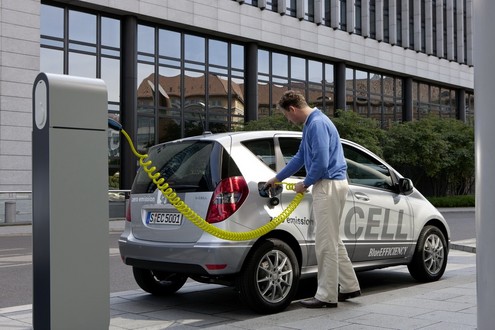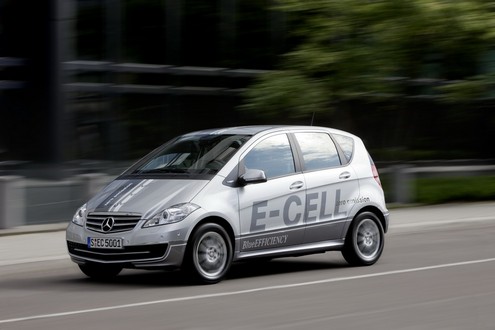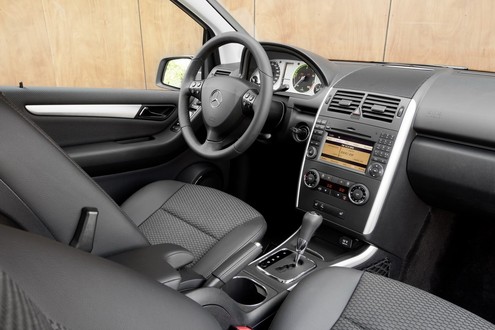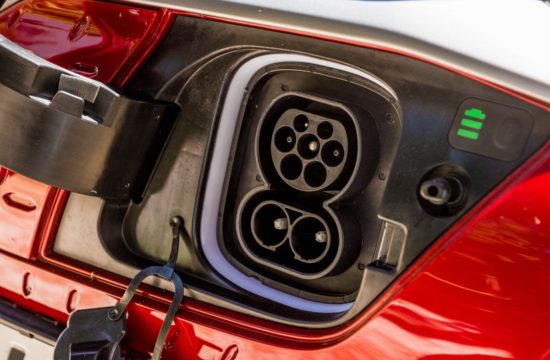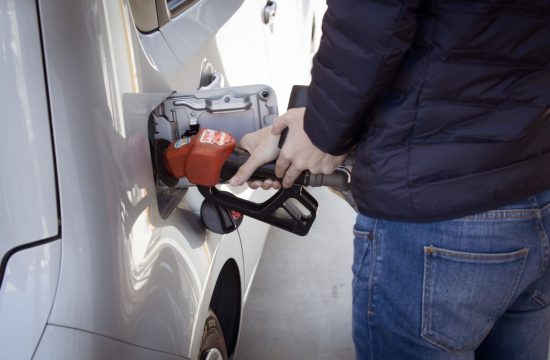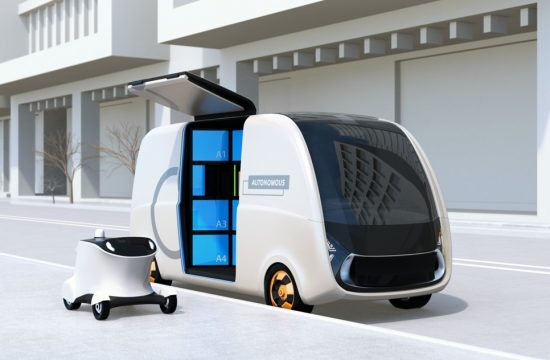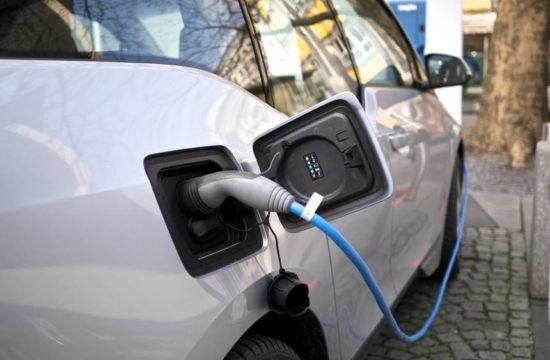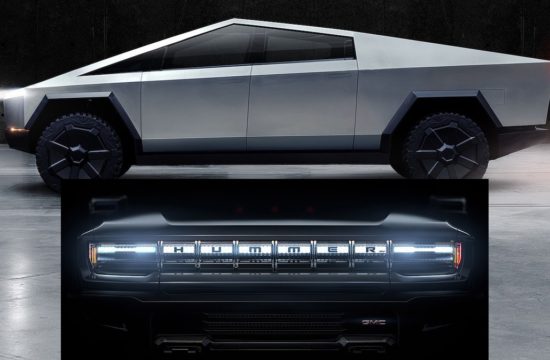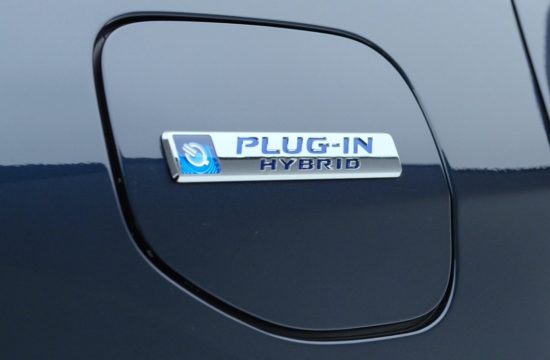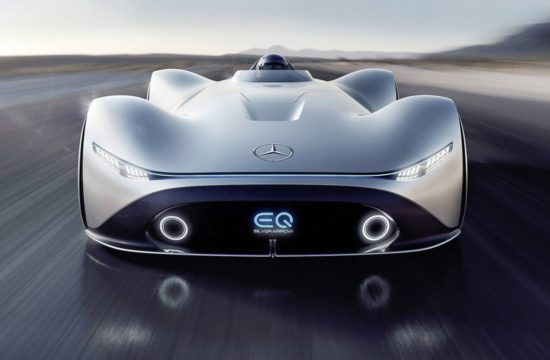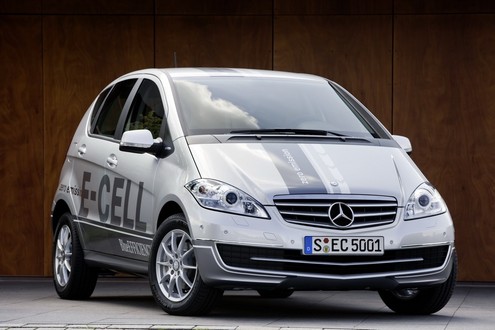
Mercedes Benz has plans to offer E-Cell electric variants of all models in future, from the supersport SLS E-Cell to the small B and A-Class E-Cell. The new one based on the current A-Class is a zero-emission five-seater city car with no compromise on comfort and space. It’s go a 95 bhp and 250 Nm electric powertrain which has a range of 125 miles.
Apart form its electric direvetrain, everything about the E-Cell is like a normal A-Class so actually they can put it in production the way it is now. And indeed they will. A total production run of 500 A-Class E-CELL cars will be built at Rastatt from autumn 2010. The vehicles will be leased to selected customers in several European countries, including Germany, France and the Netherlands.
Like a normal A-Class, the E-Cell has five doors, five seats and 435 liters boot which is expandable to 1370 litres with a payload of 350 kg. It’s got all the qualities you expect from a great daily driver, only it’s clean and cheaper to run than the regular petrol-powered cars/
“Over our almost 125-year history, we have accumulated extensive experience and know how in the area of electric vehicles, including both battery and fuel-cell. This know how has already provided the basis for getting two electric cars for everyday use onto the road: the smart fortwo electric drive, and the B-Class F-CELL. The story now continues with our third electric car, the A-Class E-CELL., whose start of production is scheduled for autumn this year. The new car is a battery-driven electric Mercedes that enlarges our portfolio and offers our customers the kind of driving pleasure, comfort and safety that they have come to expect”, says Dr Thomas Weber, the Daimler AG Board of Management member responsible for Group Research and Development Mercedes-Benz Cars.
Driving pleasure with zero emissions
Along with exemplary safety, optimum comfort and a high level of suitability for daily use, the A-Class E-CELL also offers other strengths not always found in contemporary electric cars: agility and driving pleasure. The features are based on a low centre of gravity, partly the result of the installation of the batteries under the passenger compartment, in the “sandwich” structure of the vehicle floor. This gives the car excellent road-holding and sprightly handling characteristics – qualities that clearly set the A-Class E-CELL apart from other electric cars, which often have heavy and bulky storage batteries located in the boot or by the rear seat. Another benefit from this installation location is the provision of best-possible protection against the intrusion of structural components in the event of a head-on collision or impact from the rear. This is because the batteries are located outside the vehicle body’s deformation zones. The high-stability characteristics of the sandwich structure of the floor also provide outstanding protection for both battery and passengers in a lateral collision scenario.
High-performance electric drive with long range
The electric drive of the A-Class E-CELL is a permanent-field synchronous unit developing a peak output of 95 hp, a continuous power rating of 68 hp and a high maximum torque of 290 Nm, as expected for an electric drive, available right from the first revolution. This makes the A-Class E-CELL an outstandingly assured and dynamic performer on the road, taking just 5.5 seconds to accelerate from 0-37 mph. A kick-down function is used to deliver maximum acceleration, according to the current charge level and battery temperature. Maximum speed is electronically set at 93 mph.
The energy storage units are two high-performance lithium-ion batteries based on high-voltage technology. The advantages of lithium-ion batteries include their compact dimensions and significantly higher efficiency in comparison with nickel-metal-hydride (NiMH) batteries. They offer 30 percent more energy density than NiMH technology, and 50 percent more power density. Other benefits include high charging efficiency and a long service life. The combined energy capacity of the two lithium-ion batteries is a total of 36 kWh. With fully charged batteries, the A-Class E-CELL has a range of over 124 miles (NEDC).
Efficient battery cooling system
A special thermomanagement system keeps the high-voltage batteries cooled to within an optimum temperature window. The cooling system is based on a low-temperature cooling circuit. Fluid cooling with a water-glycol mixture ensures a stable operating temperature supporting the high degree of efficiency and the longevity of the energy storage. In very high ambient temperature conditions, the battery cooling system is boosted with the coolant circuit of the air-conditioning system. The electrical drive system and two on-board chargers are cooled with a high-temperature cooling circuit. This circuit keeps the units working at optimum operating temperatures, with maximum power delivery from the drive system. The car’s power electronics supply the 12-volt vehicle electrical system via a DC/DC converter with electric current from the high-voltage system. The electronics system also controls other functions such as the heating and air-conditioning systems in order to minimise the load placed on the battery for this purpose.
Flexible charging options
The batteries of the A-Class E-CELL can be either replenished at public charging points or plugged into an ordinary household power socket. A range of charging options are available, including single-phase 230-volt sockets, three-phase sockets in a household wall-box, and public recharging points. Using a single-phase 230-volt network, it takes around eight hours’ charging time to accumulate the energy required for a range of 62 miles (NEDC). This time is reduced to just three hours in the case of charging from a wall-box or at a roadside recharging point.
Daimler and a number of other European automakers and energy utilities have agreed on standardised charging plugs and sockets, with an ultimate aim of worldwide standardisation. This makes the technology more customer-friendly, and is seen as a key prerequisite for the rapid spread of electric mobility.
Intelligent charging management
Like the smart fortwo electric drive in its category, the A-Class E-CELL is the world’s first vehicle in its class to be fitted with an intelligent charging management system based on “SmartCharge Communication”. Via the vehicle electronics system, all relevant information – such as the electricity supply contract identification data – is exchanged with the charging point. Benefits include a convenient, simple and totally reliable billing system.
Other intelligent features of the car include pre-start climate control. While the A-Class E-CELL batteries are being charged at home or at a roadside charging point, the interior can be pre-heated or cooled to a temperature set by the driver. Another function enables the driver to monitor charging progress and therefore the present range available, via the internet or a smartphone, for example.
The A-Class E-CELL electronics also provide for proactive control of the charging operation. So if the electric car is parked for a long period, recharging can be set to take place at times when electricity is cheaper, for example during the night. The intelligent interface in the A?Class E?CELL provides a range of billing, control and monitoring functions, making electric mobility convenient and safe, and therefore very customer-friendly. The vehicle is automatically immobilised on connection of the charging cable to the socket, preventing any possibility of driving off by mistake while charging is in progress. This makes the recharging operation even safer and more convenient for the user.
“Everything under control” when out on the road
To make vehicle handling and control as easy, safe and transparent as possible for the driver, the A-Class E-CELL has its own control and display concept specifically designed for the requirements of an electric car. The multifunction display in the vehicle shows the battery charge status, trip data such as kilometres driven, travelling time, average speed and average fuel consumption, along with the remaining range and residual electrical energy capacity (SoC = state of charge).
Another detail specific to the system is a display of the currently available drive power. Meanwhile, the rev counter normally to be found on the instrument panel is replaced with an indicator showing the instantaneous drive power demand or recovery power. Green, white and red-coloured segments show whether the drive system is currently operating in charge, economy or boost mode.
High-quality equipment typical for Mercedes
The new A-Class E-CELL also has plenty to offer in terms of Mercedes-quality equipment. Standard highlights in the premium quality with this innovative electric car include bi-xenon headlamps, COMAND, an active park assist for automatic parking and an automatic climate control system are all available. A special additional function is the ability to preset the interior climate during charging, i.e. raising or lowering the compartment temperature according to the weather conditions. The car also has a comprehensive range of safety features, including rear window bags and sidebags, and sophisticated seating and lighting packages.
External features of this battery-powered electric car include the standard polar silver painted body and an “E-CELL” sign in silver lettering on the boot.
Highest safety standards
Mercedes-Benz applies the same high safety standards in the A-Class E-CELL as in all its other series-produced vehicles. The electric drive system has demonstrated readiness for series production in extensive practical testing programs. Key components have also been proven in Mercedes-Benz fuel-cell vehicles, for example, allowing Mercedes engineers to draw on the experience gained from more than 4.5 million test kilometres in everyday use. The integrated safety concept reflects the specific characteristics of the vehicle’s innovative drive system. The lithium-ion batteries and high-voltage system of the A-Class E-CELL are protected with a comprehensive safety concept:
- All cables are clearly colour-coded, and safety warnings are placed on high-voltage components.
- Generously dimensioned insulators and special plugs provide full contact protection for the entire system.
- An electronic controller continuously monitors safety requirements and immediately alerts the driver to any malfunctions in the high-voltage system.
- All high-voltage components are connected in an electric loop. This means that the high-voltage system is automatically completely disconnected in the event of a malfunction or an accident.
- The high-voltage system is also automatically completely disconnected when the ignition switch is placed in the “off” position, or in the event of possible faults.
- The system is continuously monitored for short circuits.
- An automatic drive disabler activated when the charging cable is connected prevents any possibility of the car being driven off by mistake.
Modular system for electric cars
In line with the strategy used for hybrid development, Mercedes engineers have also developed a modular system for electric vehicles with battery and fuel-cell. The benefits include the efficient use of shared parts in all the brand’s electric vehicles. All the key components of electric cars are appropriate for a modular approach – for example, the electric drive of the A-Class E-CELL is also used in the B-Class F-CELL. Both energy storage units in the electric A-Class are the same as the battery in the smart fortwo electric drive.
Profile description and technical data for the A-Class E-CELL
- Locally emission-free, exclusively battery-powered electric vehicle with a range of more than 200 kilometres NEDC (new European driving cycle).
- Five-seater compact car meeting all requirements for everyday use.
- Two liquid-cooled lithium-ion batteries with 36 kWh storage capacity.
- Battery system location leaving spacious interior and luggage compartment completely unobstructed.
- Power electronics with integrated DC/DC converter for 12-volt supply.
- Front axle drive.
- THERMOTRONIC air-conditioning and pre-start climate control via charging plug.
- Series production run of 500 units to start in autumn 2010.
Drive system Electric drive, lithium-ion battery Continuous power rating (hp) 68 Peak power (boost) (hp) 95 Rated torque (Nm) 290 Maximum speed (mph) 93 Acceleration from 0 to 62 mph (s) 14 Acceleration from 0 to 37 mph (s) 5,5 Charging time for 100 km range (NEDC) 8 h from domestic mains socket (230 V) 3 h from wall-box / public charging point (400 V)
Range (miles) NEDC >124 Energy capacity of lithium-ion battery system (kWh) 36 Payload (kg)
*) As per EG directive, including driver (68 kg) and luggage (7 kg)350*) Luggage compartment volume (l) 435 – 1.370

